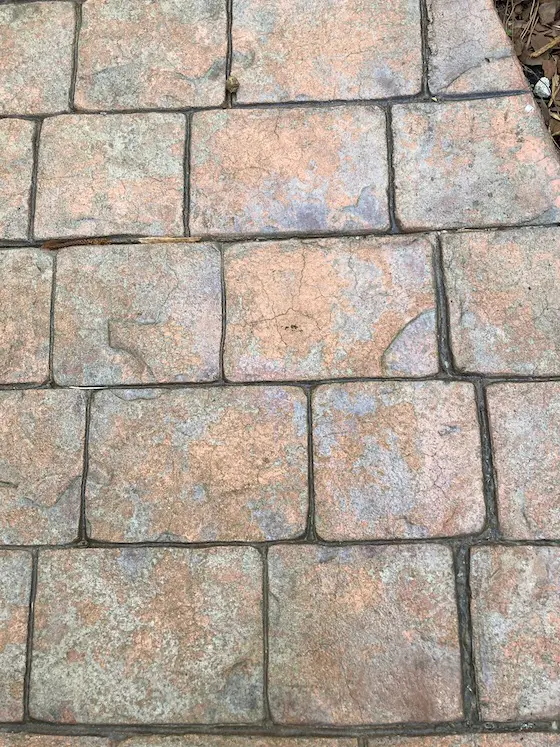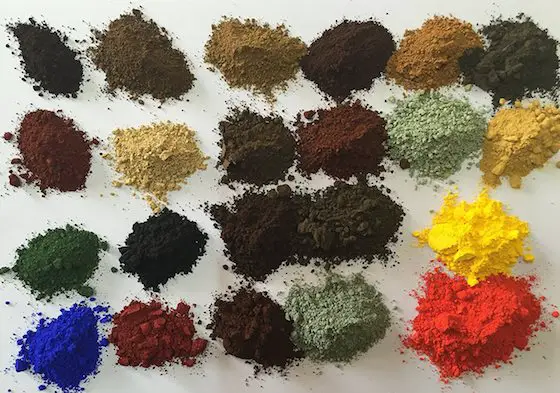Stamped Concrete Restoration

Stamped Concrete Restoration | This is a great example of damaged stamped concrete. It could be a combination of ultraviolet light damage as well as pressure washing. Copyright 2022 Tim Carter ALL RIGHTS RESERVED
How to Restore Faded Stamped Concrete
You may be wondering about how to restore faded stamped concrete. If you’ve witnessed hundreds and hundreds of full moons in your lifetime and make frequent use of your critical-thinking skills, you know the sun is constantly at work ruining things inside and outside your home. One of these might be the expensive stamped-concrete patio, driveway, or sidewalk you had installed a few years ago.
The Sun Causes Stamped Concrete Fade
The same thing happens with exterior wood stains and sealers. I just concluded a very fascinating test of a particular exterior wood stain and it looks fantastic after two years of harsh exposure to the sun. I’m convinced I may get another two years out of it, but eventually it will succumb to the sun’s ultraviolet (UV) rays.
Stamped concrete restoration is a short-term solution. You may wonder what is the exact mechanism that caused your stamped concrete, that you were probably told would look good for decades, to fade and look dull after as little as three or five years. While I was doing research for my Roofing Ripoff expose’ book a few years back, I discovered a small percentage of the sun’s UV rays contain active photons. You can READ the first few chapters of Roofing Ripoff for FREE.
Do Photons Destroy Stamped Concrete Patios?
These photons are like miniature cruise missiles. When they strike fabrics, wood stains, paint, wood, certain soft metals, etc. they can blast apart molecules and even break atomic bonds. Imagine photons being so strong they can break the atomic bonds of copper, zinc, and lead! You are fighting a powerful foe as you begin your stamped concrete restoration project.
It should now make sense to you why the zinc coating on metal roofs disappears and why roof surfaces are free of algae and mold below copper and lead flashings. The atoms broken off by the UV rays wash down the roof with each rainfall and create a poisoned field such that algae and mold can’t survive.
Can Dry Pigments Withstand UV Rays?
Knowing this, I believe you can now see why the solid pigments used by the stamped-concrete installers are child’s play for the UV rays striking your pavement. The photons simply destroy the pigments over time. But the problem is two-fold. The pigments are really not much different than a thin ganache icing on a birthday cake.
What Else Ruins Stamped Concrete or Colored Concrete Paving Brick?
Strong acids such as muriatic acid and others used by masonry contractors can ruin stamped concrete and colored concrete paving brick. These will dissolve the cement paste that contains the dry pigments that create the color. You'll be left seeing the actual dull color of the sand and stones in the concrete.
What Creates the Color in Stamped Concrete?
The color in your stamped concrete comes from pigments that have the consistency of cake flour for the most part. The concrete finisher broadcasts these dry pigments on top of the wet concrete and uses a wide float to get them to mix with the Portland cement paste that is coating all of the particles of sand and gravel in a thin top-layer of the concrete.

Here are just a few of the many many dry pigments available. You can blend different pigments to get different shades that you don't see here! YOU CAN BUY ANY WHITEWASH OR CONCRETE PIGMENT YOU WANT BY JUST CLICKING THE PHOTO.
How Thick is the Colored Cement Paste?
This cement-paste covering is extremely thin. While the cement paste can be sticky and bond well to the sand and gravel, it can be worn off with normal foot traffic and regular rainfall. Pressure washing a pigmented concrete slab is the kiss of death. Nothing ruins the appearance of stamped concrete faster than pressure washing its surface. I have photographs here on my AsktheBuilder website of new vs pressure-washed colored concrete paving bricks. The difference is like night vs. day.

I cracked the new precast concrete paving brick in half. Look at how light-colored the aggregate is! Over time when the red cement paste wears off, the pavers will look different. My traditional clay paving brick patio under the cracked brick will stay red forever, because the red clay is the same color throughout the entire brick. © 2022 Tim Carter
When you remove this ultra-thin coating of colorized cement paste from the sand and gravel in the concrete, you begin to see the actual color of those components. What’s more, if you’ve ever looked closely at these stones you’ll discover they’re often quite smooth. Think how poorly a normal liquid stain adheres to a piece of glass - not well.
How to Restore Stamped Concrete
There are two methods that work to add color to restore faded stamped concrete or previously stained stamped concrete. You can use reactive or non-reactive stains. The reactive acid stains contain metallic salts that can chemically react with the Portland cement paste and add color. The non-reactive stains are normally just films that try to adhere to the concrete, sand, and gravel.
You simply need to manage your expectations when using either of these products constantly keeping in mind what the photons are going to do. They, as well as high-pressure concentrated streams of water, will eventually cause the restoration stains to fade and not look so good. How long will it take? That’s the million-dollar question!
Can Paving Brick Resist Photon Damage?
If you want a colorized pavement that the color will last for hundreds of years, you need to use traditional paving brick or natural stone. The color of the clay is solid throughout each brick. If you purchase brick that has a severe-weathering rating, it can withstand decades of Mother Nature’s abuse. Just travel to Athens, Ohio and marvel at the paving brick still visible on a few of its downtown streets. It’s unchanged since it was installed well over 100 years ago.
While the color range might not be as wide as with paving brick, you can also use pieces of natural stone colorized by Mother Nature. Granite is a great example. Think of how the color of granite never changes over time. You know this to be true if you visit cemeteries on a regular basis and note the granite headstones.
Are Granite Cobblestones a Good Alternative?
Granite cobblestones may be available to you in a wide-variety of different muted colors. There’s a stunning red granite bedrock on Mt. Desert Island in Maine, but that quarry has long since ceased operation. White or light-gray granite is usually the cobblestone I see in stock at most stone supply businesses.
Column 1453